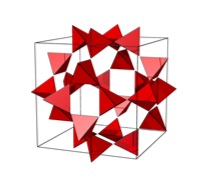New Ways to Fill Space with Tetrahedra and Octahedra

- Filling space with polyhedra is a problem dating back to at least to the ancient Greeks. Such space-filling structures (also called “tilings”) have an intimate relationship to the spatial arrangement of crystals, quasicrystals, and DNA, and have important applications in communications, cryptography, information theory and in the search for gravitational waves.
- It was long believed that tilings associated with the fcc crystal and its close relatives (called the “octet truss” by Buckminster Fuller) were the only tilings composed of regular tetrahedra and octahedra. In this work, we have identified and analyzed a new family of a infinite number of periodic tilings of 3D space with regular tetrahedra and octahedra. The periodic repeat unit of the tilings contains an octahedron contacting six smaller tetrahedra, which makes the tilings distinctly different and combinatorically richer than the fcc tiling.
- The repeat units of our tilings resemble molecular clusters with various symmetries. How these clusters self-assemble determines their fundamental material properties. These new tilings could be used to model complex multi- component molecular and nano-particle systems under high pressure and enable one to design unique building blocks for targeted self-assembly.
- J. Conway, Y. Jiao, S. Torquato, PNAS 2011, in press.
